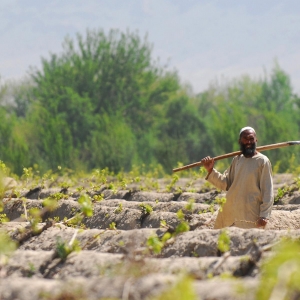Federal Water Tap, November 25: Superfund Sites at Risk from Climate Change
The Rundown
A government watchdog highlights climate risks to heavily polluted sites. Energy regulators receive a pumped storage hydropower proposal for West Virginia. A House committee advances a package of PFAS bills. A federal appeals court upholds highest priority water rights for Klamath River basin tribes. An EPA financing advisory committee will hold public teleconferences on stormwater funding, while the EPA releases its annual environmental justice report. And lastly, drought conditions are expected to emerge on the central California coast this winter.
“In the absence of strong leadership at the EPA or the military, it requires the Congress to act.” — Rep. Debbie Dingell (D-MI) speaking at a House Energy and Commerce Committee markup session addressing “forever” chemicals, also known as PFAS. The committee approved a PFAS package that incorporates a dozen bills. The package addresses a number of pressing issues. It requires the EPA to designate the two most-studied of the chemicals (PFOA and PFOS) as hazardous substances under the federal Superfund law. It orders the EPA to publish drinking water regulations within two years for PFOA and PFOS. And it expands the monitoring program for PFAS in drinking water.
By the Numbers
12: Stream gauges on waterways in eastern Oklahoma that marked a record-high peak flow during heavy rains that started in late May of this year. (U.S. Geological Survey)
News Briefs
West Virginia Hydropower Project Proposed
FreedomWorks, LLC filed an application with federal energy regulators for a permit to do site assessments for a proposed hydropower project in West Virginia.
The Ulysses project would involve a type of hydropower generation called pumped storage that uses twinned reservoirs. A pumped storage system releases water from the upper reservoir to generate power when demand is high. The water is stored in the lower reservoir and pumped back uphill when energy prices are lower, typically overnight. Though a net loss of energy, it is a valuable form of battery storage.
The Ulysses project would require two new reservoirs, each with a surface area larger than 1,000 acres.
This is not the first pumped storage proposal in the state from FreedomWorks, which is based in Harpers Ferry, West Virginia.
The U.S. Forest Service denied FreedomWorks access to the Monongahela National Forest in March to do site assessments for the proposed Big Run project. Like for the Ulysses project, two new reservoirs would be constructed for Big Run.
Shawn Cochran, the Monongahela forest supervisor, wrote that the proposed project, which would disturb protected wetlands in Big Run bog, was “inconsistent” with forest management goals. The bog, designated a National Natural Landmark by the National Parks Service, is habitat for threatened species.
The federal government has shown interest in boosting pumped storage. The Department of Energy is now holding a prize competition to generate ideas on how to quicken the design and construction of pumped storage systems. Despite the interest, few projects have materialized. The most recent project to come online was in 2012, according to the Energy Information Administration.
Klamath Water Rights
A federal appeals court ruled that the water rights of Native American tribes in the Klamath River basin have priority over other users, the Times-Standard reports.
The Klamath flows through Oregon, California, and the reservation of the Yurok Tribe. The Hoopa and Klamath tribes are also located in the basin.
Farmers in the Klamath filed the lawsuit in 2001 after the federal government cut off irrigation water during a dry year in order to protect endangered fish that the tribes rely on.
Studies and Reports
Climate Risks for Superfund Sites
About 60 percent of Superfund sites not owned by the federal government are in areas at risk of damaging effects from climate change, according to a government watchdog’s report.
Using federal data sets, the Government Accountability Office tallied the number of sites exposed to flooding, wildfire, storm surge, and rising seas. Nine hundred forty-five sites had at least one identified risk factor. Of those sites, three-fifths were exposed to flooding, the most common hazard.
The true number of at-risk sites may be higher, the GAO warns. The EPA, for example, does not have accurate maps that show the boundaries of nonfederal Superfund sites, according to the report.
Government Funding for Climate Adaptation
The federal government lacks a coherent strategy for funding climate resilience projects, according to a GAO assessment.
The GAO offered two approaches for resolving the problem and acknowledged their strengths and weaknesses. One, agencies could better coordinate existing programs and funding decisions. This option retains the flexibility of multiple funding streams but can be logistically bedeviling, the report states.
Or, Congress could establish a new federal funding source that concentrates on climate resilience. Having a central authority would simplify administrative processes. But it could result in climate resilience being sidelined within major agencies.
A positive example the GAO put forward is the Louisiana Coastal Protection and Restoration Authority, which is a single coastal planning agency created by the state Legislature in 2005.
Environmental Justice Report
The EPA published an annual report of its actions in 2019 to promote clean environments in poor and minority communities.
On the Radar
California Drought Watch
The National Weather Service says that drought conditions are likely to emerge along the central California coast in the next three months.
Environmental Finance Public Meeting
The expert group that advises the EPA on financing will hold two public teleconferences in the coming weeks. On the calls, the group will discuss a report it is preparing on how to finance improvements in stormwater treatment and control.
The first call is scheduled for December 4 and the second for December 18. To register, send an email to waterfinancecenter@epa.gov.
Federal Water Tap is a weekly digest spotting trends in U.S. government water policy. To get more water news, follow Circle of Blue on Twitter and sign up for our newsletter.
Brett writes about agriculture, energy, infrastructure, and the politics and economics of water in the United States. He also writes the Federal Water Tap, Circle of Blue’s weekly digest of U.S. government water news. He is the winner of two Society of Environmental Journalists reporting awards, one of the top honors in American environmental journalism: first place for explanatory reporting for a series on septic system pollution in the United States(2016) and third place for beat reporting in a small market (2014). He received the Sierra Club’s Distinguished Service Award in 2018. Brett lives in Seattle, where he hikes the mountains and bakes pies. Contact Brett Walton






Leave a Reply
Want to join the discussion?Feel free to contribute!